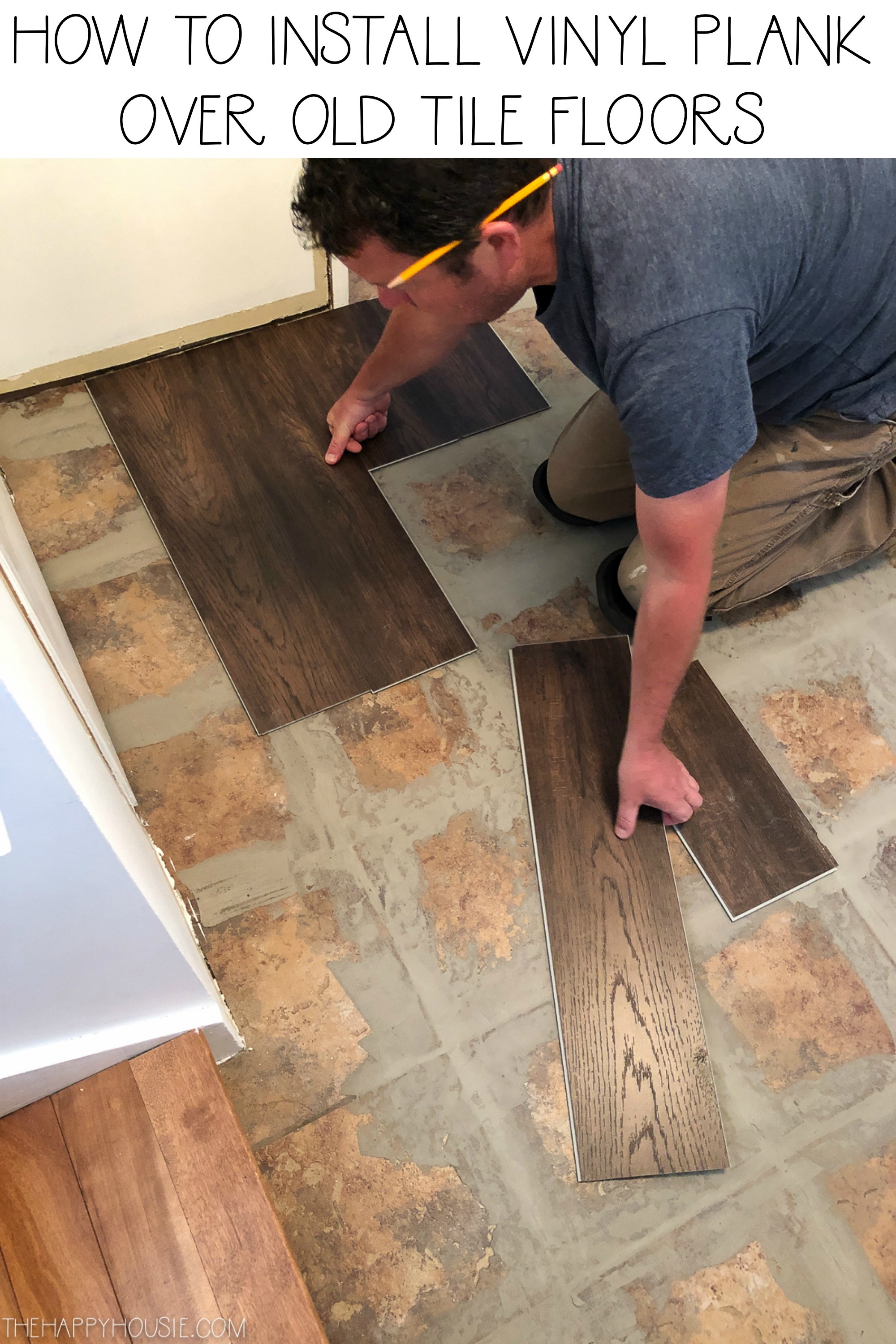Can You Install Hardwood Over Tile? Expert Tips & Tricks

Yes, you can install hardwood over tile. It is possible with the right preparation.
First, ensure the tile is flat and stable. Many homeowners dream of having hardwood floors. They are beautiful and timeless. But ripping out existing tile can be messy and costly.
So, can you install hardwood over tile?
Absolutely! It’s a practical solution.
But it requires careful planning. The tile must be in good condition. No cracks or loose pieces. Also, the surface must be level. This ensures the hardwood lays flat. It’s important to use the right materials and techniques.
Can You Install Hardwood Over Tile? From Preparation to Installation, Learn How to Achieve a Stunning Hardwood Floor Over Your Tile. This blog will guide you through the process.
Introduction To Hardwood Installation Over Tile
Many homeowners dream of having hardwood floors. They bring warmth, style, and elegance to any room.
But what if you already have tile flooring? Is it possible to install hardwood over tile?
The answer is yes. You can lay hardwood over tile, but there are a few important things to consider.
Why Consider Hardwood Over Tile?
Tile floors can be hard and cold. They may lack the warmth and comfort of hardwood. Hardwood floors can transform a space. They add a touch of luxury and timeless beauty. Here are some reasons to consider hardwood over tile:
- Aesthetic Appeal: Hardwood floors are visually appealing.
- Comfort: Hardwood is warmer and softer underfoot.
- Resale Value: Hardwood can increase the value of your home.
- Easy Maintenance: Hardwood is easier to clean than tile.
Challenges And Benefits
Can you install hardwood over tile? While it comes with its own set of challenges and benefits, here’s what you need to know. It’s important to weigh both before making a decision.
| Challenges | Benefits |
|---|---|
| Height Issues: Adding hardwood on top of tile increases floor height. | Quick Installation: No need to remove existing tile, saving time. |
| Subfloor Preparation: The tile must be level and in good condition. | Cost Savings: Avoiding tile removal can save money. |
| Adhesion: Proper adhesive is needed for bonding hardwood to tile. | Less Dust: No tile removal means less dust and debris. |
| Moisture Concerns: Tile must be dry to avoid moisture issues. | Modern Look: Hardwood gives a modern and updated look. |
Before starting the project, ensure the tile is in good condition. No loose or cracked tiles. A smooth, clean surface is crucial for a successful installation. Proper preparation ensures your new hardwood floor will last for years.
Assessing The Existing Tile Floor
Before asking, ‘Can you install hardwood over tile?’ it’s crucial to assess the existing tile floor. This step ensures that the new hardwood installation will be durable and stable.
Evaluating the current condition of the tile floor involves checking for damage and ensuring the surface is level.
Checking For Damage
Examine the tile floor for any signs of damage. Look for:
- Cracks or chips in the tiles
- Loose or missing tiles
- Grout in poor condition
Cracks or chips can cause uneven surfaces. Loose or missing tiles indicate instability. Poor grout condition might lead to moisture issues. Address these problems before proceeding with the hardwood installation.
Ensuring Level Surface
A level surface is vital for a successful hardwood installation. Use a spirit level to check the floor. Ensure there are no significant high or low spots. If you find any uneven areas, use a self-leveling compound to even them out.
Here’s a simple table to guide you:
| Issue | Solution |
|---|---|
| High spots | Grind down the high areas |
| Low spots | Fill with self-leveling compound |
Ensuring the surface is level will prevent future problems with your hardwood flooring. Leveling the floor guarantees a smooth and durable installation.
Preparation Steps
Are you thinking about: can you install hardwood over tile? Proper preparation is crucial. Follow these steps to ensure a smooth and successful installation.
Cleaning The Tile Surface
Start by cleaning the tile surface. This is a very important step. Remove all dirt, dust, and grease. Use a vacuum to pick up loose debris. Then, mop the floor with a mild detergent and water. Let the floor dry completely before moving to the next step.
Sanding For Better Adhesion
Next, sand the tile surface. This helps the adhesive bond better. Use coarse-grit sandpaper for this task. Sand the entire surface evenly. Make sure to wear a mask to avoid inhaling dust.
After sanding, vacuum the floor again to remove all dust particles. Wipe the surface with a damp cloth to ensure it is clean.
By following these preparation steps, you will ensure a strong foundation for your hardwood installation. Clean and sand the tile surface thoroughly for the best results.

Credit: www.reddit.com
Choosing The Right Hardwood
Choosing the right hardwood for installation over tile is crucial. The type and thickness of the hardwood can affect the final look and durability of your floor. Understanding these elements can help you make the best choice for your home.
Types Of Hardwood
Various types of hardwood are available. Each has its characteristics. Oak is a popular choice. It is strong and has a classic look. Maple is another option.
It is durable and has a smooth texture. Cherry wood offers rich color and elegance. Bamboo is also a good choice. It is eco-friendly and resilient.
Considerations For Thickness
The thickness of hardwood matters. Thicker boards are more durable. They can be sanded and refinished multiple times. This extends the life of your floor. Thinner boards are easier to install. They are also more flexible. This flexibility can help with uneven tiles.
Consider the height of your existing floor. Thicker hardwood can raise the floor level. This might affect doors and cabinets. Measure carefully before deciding. Choose a thickness that fits your needs.
Installation Methods
Installing hardwood over tile can be a great way to update your floors. There are different methods to achieve this. Each method offers unique benefits and challenges. Understanding these methods can help you choose the right one for your project.
Floating Floor Method
The floating floor method is popular for installing hardwood over tile. It involves placing hardwood planks on top of the tile without glue or nails.
Instead, the planks lock together using a tongue-and-groove system. This method is quick and easy. It is also less invasive since it does not require damaging the existing tile.
Before starting, ensure the tile is level and clean. Any bumps or uneven spots can affect the final result.
Use a moisture barrier to prevent issues with humidity. This method also allows for easy removal if needed in the future. It is a versatile and user-friendly option.
Glue-down Method
The glue-down method is another way to install hardwood over tile. This method involves applying a strong adhesive to secure the hardwood planks directly to the tile. It creates a solid and permanent bond. This method is ideal for high-traffic areas.
Preparation is crucial with the glue-down method. The tile surface must be clean and dry. Any debris can prevent proper adhesion.
Spread the adhesive evenly and press the planks firmly into place. Allow the glue to cure fully before walking on the floor. This method provides a durable and stable result.
Tools And Materials Needed
If you’re asking, ‘Can you install hardwood over tile?’, you’ll need the right tools and materials. This guide covers the essentials to help you answer that question. Start with the basics and gather everything before you begin.
Essential Tools
Several tools will make the job easier. These tools ensure a smooth installation process. Here’s what you need:
- Measuring Tape: Accurate measurements are crucial.
- Circular Saw: For cutting hardwood to fit.
- Hammer: To secure the planks.
- Nail Gun: Speeds up the nailing process.
- Level: Ensures the floor is even.
- Pry Bar: Helps in removing any obstacles.
- Rubber Mallet: To tap the planks into place.
- Safety Gear: Goggles and gloves to protect yourself.
Required Materials
Having the right materials is just as important. These materials are essential for a successful installation:
- Hardwood Planks: Choose your desired wood type.
- Underlayment: Provides a moisture barrier and cushioning.
- Adhesive: To bond the hardwood to the tile.
- Nails: Use them to secure the planks.
- Wood Filler: For filling gaps and holes.
- Trim and Molding: To give the floor a finished look.
- Plastic Sheeting: Protects surfaces from dust and debris.
Gather these tools and materials before you start. Proper preparation ensures a smoother installation process. Happy flooring!
Step-by-step Installation Guide
Installing hardwood over tile can be a great way to update your floors without the mess of removing tile. Follow this step-by-step guide to ensure a smooth installation process.
Laying The Underlayment
To begin, you need to lay an underlayment over your tile floor. Underlayment acts as a moisture barrier and provides a smooth surface for the hardwood. Here are the steps:
- Clean the tile surface. Remove all dirt and debris.
- Measure the area. Cut the underlayment to fit the space.
- Lay the underlayment sheets. Ensure they are flat and even.
- Tape the seams. Use underlayment tape to secure the edges.
Placing The Hardwood
Once the underlayment is in place, you can start laying the hardwood. Here’s how:
- Acclimate the hardwood. Let it sit in the room for 48 hours.
- Start at the longest wall. Place the first row of hardwood planks.
- Use spacers. Maintain a small gap between the wall and the planks.
- Stagger the joints. Ensure the ends of the planks do not line up.
- Secure the planks. Use a nail gun or adhesive as needed.
- Continue laying planks. Work row by row until the floor is covered.
- Remove spacers. Fill the gaps with matching trim or molding.
Installing hardwood over tile is a manageable project. With careful preparation and precise steps, you can achieve a beautiful, updated floor.
Post-installation Tips
Thinking about installing hardwood over tile? Make sure the existing tile is clean, level, and securely attached. Consider using a moisture barrier to prevent damage.
After installing hardwood over tile, taking care of your new floor is crucial. Proper maintenance ensures the longevity and beauty of your hardwood. Below are some essential tips to follow post-installation.
Ensuring Proper Ventilation
Good ventilation helps maintain hardwood floors. Make sure rooms have adequate airflow. Use fans or open windows to keep air circulating.
This prevents moisture buildup, which can harm hardwood. Check that your HVAC system works well. Proper ventilation keeps your floor in top condition.
Maintenance And Care
Regular cleaning is key to maintaining hardwood. Sweep or vacuum floors weekly to remove dust. Use a damp mop with a hardwood-safe cleaner. Avoid excessive water, as it can damage the wood. Place mats at entrances to catch dirt and moisture. This protects the floor from scratches and spills.
Inspect your floor periodically for any signs of damage. Address scratches and scuffs promptly. Use furniture pads to prevent marks from heavy furniture. Maintain a consistent indoor temperature to avoid wood expansion and contraction.
Following these tips will keep your hardwood floors looking beautiful for years to come.
Common Mistakes To Avoid
Installing hardwood over tile can be a great way to update your home’s look. Yet, many people make common mistakes during this process. Avoiding these errors can ensure a smooth and successful installation. Let’s explore some of the most frequent mistakes you should avoid.
Ignoring Tile Condition
The condition of the existing tile is crucial. Damaged or uneven tiles can cause issues. Check for cracks, loose tiles, or uneven surfaces. Fix these problems before starting the hardwood installation.
Neglecting this step can lead to an unstable floor. Your new hardwood may not sit properly. This can cause it to wear out faster.
Skipping Surface Preparation
Surface preparation is vital for a successful hardwood installation. Clean the tile surface thoroughly. Remove any dirt, grease, or debris. Ensure the surface is dry and even.
Use a leveling compound if needed. This step ensures the adhesive bonds well. Skipping it can result in the hardwood not adhering properly. This can lead to gaps or buckling in the floor.

Credit: www.thehappyhousie.com
Expert Advice And Recommendations
Can you install hardwood over tile? Yes, it’s possible with proper preparation. Ensure the tile is level and secured before laying the hardwood. This approach saves time and avoids the mess of tile removal.
Installing hardwood over tile can be tricky. The process involves many steps and considerations. Expert advice can help you make the right decision. Below are some key points to think about.
Consulting A Professional
Consulting a professional can save you time and stress. Experts can assess the condition of your tile. They will check for any damage or uneven surfaces. They can recommend the best type of hardwood for your space. This ensures a long-lasting and beautiful floor.
Professionals can also identify potential issues early. This helps prevent costly repairs in the future. A consultation can provide peace of mind. You will know your project is in good hands.
Diy Vs Professional Installation
DIY installation can seem like a budget-friendly option. It allows you to work at your own pace. You can also learn new skills. But, it can be challenging without the right tools and experience. Mistakes can be costly and time-consuming to fix.
Professional installation ensures a high-quality finish. Experts have the right tools and skills. They can complete the job quickly and efficiently. This can save you time and reduce stress.
Weighing the pros and cons of each option is important. Consider your budget, time, and skill level. This will help you make the best choice for your hardwood installation.

Frequently Asked Questions
Can you install Hardwood Over Tile?
Yes, hardwood can be installed over tile. Proper preparation is key. The tile must be level, clean, and in good condition.
What Is Needed To Install Hardwood Over Tile?
You need a moisture barrier, underlayment, and appropriate adhesive. Ensure the tile surface is clean and level.
Is It Expensive To Install Hardwood Over Tile?
Costs vary based on materials and labor. It’s generally more expensive than a direct installation due to extra preparation.
Do I Need To Remove Tile Before Installing Hardwood?
No, you don’t have to remove the tile. Proper preparation and installation techniques allow hardwood to go over tile.
Conclusion
Installing hardwood over tile is possible with the right approach. Ensure your tile is level, clean, and secure. A proper underlayment is essential for a smooth installation. Choose the correct adhesive for a strong bond. Consult with a professional if unsure about any step.
This process can enhance the beauty of your home. Enjoy the warmth and elegance of hardwood flooring.








